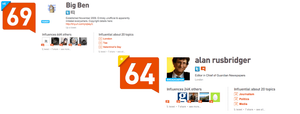Q: When is a Tweeting clock more influential than the editor in Chief of the Guardian?
A: When you rely on a flawed algorithm like Klout to measure influence
Klout is an algorithm which promises to ‘measure influence’ in social media. But (as I seem to be arguing a lot recently) it’s immensely flawed. It’s also getting huge amounts of attention – yesterday/today (in Wired and the Wallblog) and last week, from Mark Shaefer, who was in London to promote his book Return on Influence).
As social media started to come under the wing of Marketing Directors and e-commerce teams, it was only natural that the ROI of social media activity would come under the same scrutiny as other comms. But because social media is by its nature networked and leads indirectly to people saying or doing things, and cause and effect is therefore harder to measure, companies like Klout and Peer Index started to offer ‘proxy scores’ of influence – to help marketing managers decide who is ‘influential’, based on social media footprint and activity.
But the fact that a tweeting clock‘s Klout score (69) is higher than Alan Rusbridger‘s (64) shows the system up for what it is – blunt, oversimplified, and just plain wrong.
Understanding influence is a social science of its own. Measuring it adds even more complexity. And one of the central concepts of influence is that it depends on who’s asking. So reducing ‘influence’ to one number, irrespective of the algorithm behind it, is always going to fail. Yes, a Klout or Peer Index score can help to identify some people’s networks, but it’s incredibly short-sighted to rely upon it.
As a social business consultant, when I’m asked to identify influential people in a community I never start with Klout. I always start with a question. The same question we start with when writing a communications strategy.
Why?
Why do clients want to identify these people? What do we want them to do once we’ve identified them? How likely are they to actually do what we want? Where do they hang out online, and who do they talk to? I take a lead from the PR industry, from years spent creating stakeholder maps, using a mix of data and gut feel to understand a community, ideally from within it.
Newer start-ups in this space, like Kred, are much more subtle in their identification and application of influence. But there’s still a long way to go – I recently blogged about how measuring social media influence is like nailing jelly to a wall. It will remain so for several years to come.
Until yesterday, @big_ben_clock was deemed to be ‘influential’ in drugs because it regularly used the word ‘bong’ in its tweets. In fact it pretty much only uses the word ‘bong’. That’s how wrong Klout can be.
(This is a slightly updated version of a post originally written for Cogs Agency)






